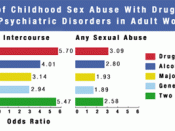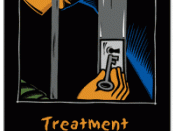The overall picture of drug abuse in the Unites States is constantly changing. The impact of drug abuse is a major public health problem that affects society on multiple levels. Directly or indirectly, every community is affected by drug abuse, as is every family. Drugs take a tremendous toll on our society at many levels. This paper will discuss the past and current trends of drug use, how American culture supports encourages and supports drug use and abuse, cultural appropriateness of specific narcotics for medical use, and health problems associated with drug abuse.
Until the late 1800's, prohibitionists found it relatively easy to identify their targets for attack: Tobacco users were conspicuous, alcohol drinkers could be found in every saloon, and alcohol was served openly in homes and at social gatherings. Even opium dens were well known and opium could be purchased readily, free from state or federal government controls.
The Jamestown settlers brought cannabis to Virginia in 1611 and cultivated it for its fiber. From then until after the Civil War, the marihuana plant was a major crop in North America, and played an important role in both colonial and national economic policyâ¦George Washington was growing hemp in 1765 at Mount Vernonâ¦presumably for its fiber, though it has been argued that Washington was also concerned to increase the intoxicating potency of his marihuana plants (Brecher, 1972)The anti-drug movements of the twentieth century could even be considered the result of the early prohibitionists. Until the Controlled Substance Act was passed by Congress in 1970, drug abuse legislation was at odds to keep pace with the endless variety of natural substances and preparations, synthetic derivatives and "improvements" on the natural that were adopted by different subcultures in the search for a new high or an intensified religious experience (Casey, 1978).
In an interview with Hardy Cannon, an elderly friend, he said that when he was growing up "no one really thought that much about drug abuse. We had tobacco, alcohol, a little pot, and a few people did a bit of the harder stuff but no one really knew how bad this stuff was for you." Hardy went on to say that "now days we hear about all the different drugs and how bad all the drugs and drinking are for you and we try to pass this onto the younger people so that they don't even get started on them". Hardy also says that "I'm glad that I'm not a youngster nowadays because of all the pressure kids have to do drugs and all just to be a part of the group."The American culture supports and encourages the use and abuse of drugs by the fact that many Americans believe that drug abuse is not their problem. They have misconceptions that drug users belong to a segment of society different from their own or that drug abuse is remote from their environment. Illegal drugs continue to be readily available almost anywhere in the United States. If measured solely in terms of price and purity, cocaine, heroin, and marijuana prove to be more available than they were a decade ago when the number of cocaine and marijuana users was much higher.
American culture also encourages and supports drug use and abuse in the following ways:â¢Permissive parental attitudes towards useâ¢Parental drug abuseâ¢Psychological characteristics: low self esteem, high anxiety, depression, eating disordersâ¢Stressâ¢Perceived norm of peer acceptance of drug abuseâ¢Expectations that drugs reduce stressâ¢Expectations that drugs increase social acceptance(UCSC AOD Abuse Prevention Program, 2006)Another example of how culture interacts to shape behavior in drug use is provided by a study by Charles Grob and Marlene Dobkin de Rios (1992). An implication of the analysis is that "the erosion of values and purposes in the minds of many contemporary adolescents, the absence of institutions concerned with promoting and managing a culturally meaningful transition into adulthood, and ready availability of drugs possessed of no sacred, socially celebratory functions are key factors that promote substance abuse, a prominent form of contemporary adolescent psychopathology" (Drug Policy Alliance, 2007).
According to the National Institute on Drug Abuse (NIDA), the results from the Monitoring the Future Program, which surveys 8th, 10th, and 12th graders reported that "methamphetamine use has doubled in the last decade" (National Institute of Drug Abuse, 2006). Even though these results only address methamphetamine use, teenagers have increased their use of other drugs as well. This increase in teenage drug use indicated that many factors such as peer pressure, increase family problems, and a curiosity to experiment with drugs has increased. In our culture where good looks, popularity, and economic status have placed more stress on teenagers' society has unwittingly supported an increase in not only teenagers but adults as well.
Prescription drug abuse is currently on the rise. According to Kenneth Tunnell in his article The Oxycontin Epidemic and Crime Panic in Rural Kentucky, "The prescription drug abuse problem has steadily increased during the past three decadesâ¦and continues to be the number one concern in Kentucky law enforcement"(Tunnell, Summer 2005). According to Tunnell "Oxycontin abuse is a highly localized problem requiring specific interpretations. Prescription fraud has largely been ignores by medical, academic, and legal communities⦠and the design of Oxycontin makes it easy to abuse" (Tunnell).
Though the use of cocaine has decreased in the United States crack has increased. A reason why crack became popular is because it does not need to be injected thus decreasing the risk of contracting the AIDS virus. According to Carroll (2000), cocaine is the most powerful stimulant of natural origin. Most users snort or inject the drug for a quicker "high".
In the clinical setting prescription drugs that have been abused or used for nonmedical reasons can send the abuser to the Intensive Care Unit (ICU). This is due to the effects of the drugs which can alter brain activity and lead to dependence. Some of these effects are seizures, agitation, harm to self, delirium, and cardiac arrest to name a few. "Commonly abused classes of prescription drugs include Opioids (often prescribed to treat pain), central nervous system depressants (often prescribed to treat anxiety and sleep disorders), and stimulants (prescribed to treat narcolepsy, ADHD, and obesity)" (National Institute of Drug Abuse, 2006).
"Commonly used Opioids include oxycodone (OxyContin), propoxyphene (Darvon), hydrocodone (Vicodin), hydromorphone (Dilaudid), meperidine (Demerol), and diphenoxylate (Lomotil). Common central nervous system depressants include barbiturates such as pentobarbital sodium (Nembutal), and benzodiazepines such as diazepam (Valium) and alprazolam (Xanax). Stimulants include dextroamphetamine (Dexedrine) and methylphenidate (Ritalin)" (National Institute of Drug Abuse, 2006).
Families often do not understand that many of the properties associated with drug addiction are linked to brain disease. Although many drug addicts initially started using their drug of choice voluntarily, their drug abuse has been shown to alter genes and brain circuitry, which affects the drug addict's behavior. "Once addiction develops, these brain changes interfere with an individual's ability to make voluntary decisions, leading to compulsive drug craving, seeking and use" (National Institute of Drug Abuse, 2007).
"The impact of addiction can be far reaching. Cardiovascular disease, stroke, cancer, HIV/AIDS, hepatitis, and lung disease can all be affected by drug abuse. Some of these effects occur when drugs are used at high doses or after prolonged use; however, some may occur after just one use" (National Institute of Drug Abuse, 2007).
Habit forming drugs continue to be introduced into American society. These drugs are widely used for medicinal purposes and many are considered to be miracle drugs. Drugs can range from cigarettes to alcohol to cocaine, and what one group may consider a problem may be another group's cherished activity. While society is taking steps in the right direction by supporting treatment programs and drug abuse prevention programs much more needs to be done to lower the current trends of substance abuse in our culture.
ReferencesBrecher, E. M. (1972). Licit and Micit Drugs. Boston: Little, Brown and Company.
Carroll, C. (2000). Drugs in Modern Society (5th ed.). Boston: McGraw-Hill.
Casey, E. (1978). History of drug use and drug users in the united states. Retrieved April 15, 2007, from http://www.druglibrary.org/schaffer/History/CASEY1.htmDrug Policy Alliance (2007). Adolescent drug use in cross-cultural perspective. Retrieved April 15, 2007, from http://www.drugpolicy.org/library/grob2.cfmNational Institute of Drug Abuse (2007). Medical consequences of drug abuse. Retrieved April 15, 2007, from http://www.nida.nih.gov/consequencesNational Institute of Drug Abuse (2006). Monitoring the future survey. Retrieved April 15, 2007, from http://wwwdrugabuse.gov/DrugPages/MTF.htmlNational Institute of Drug Abuse (2006). Trends in prescription drug abuse. Retrieved April 15, 2007, from http://www.nida.nih.gov/ResearchReports/Prescription/prescription5.html#TrendsTunnell, K. D. (Summer 2005). The oxycontin epidemic and crime panic in rural kentucky. Contemporary Drug Problems, 32(2), pp. 225-258.
UCSC AOD Abuse Prevention Program (2006). Alcohol and other drug abuse prevention program. Retrieved April 15, 2007, from http://www2.ucsc.edu/aod/index.html


